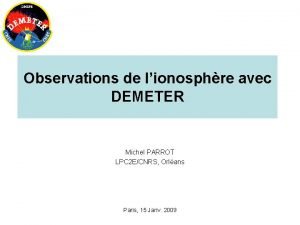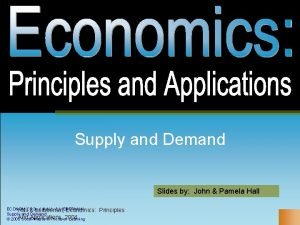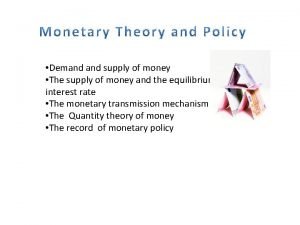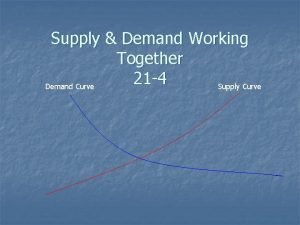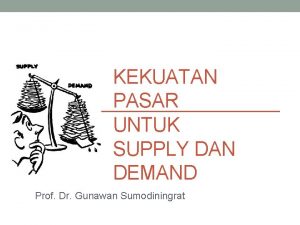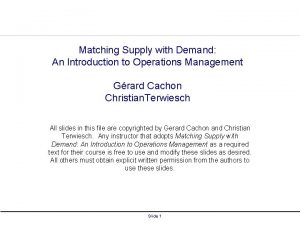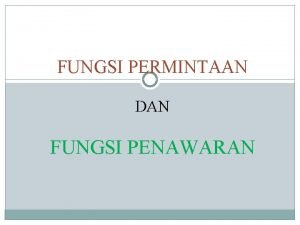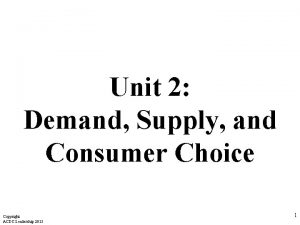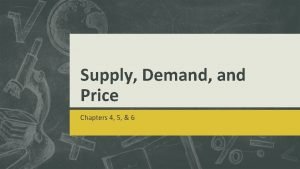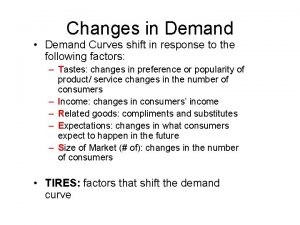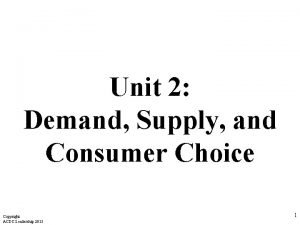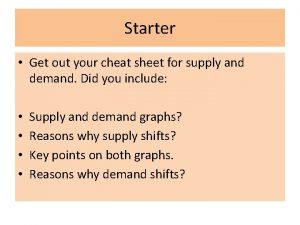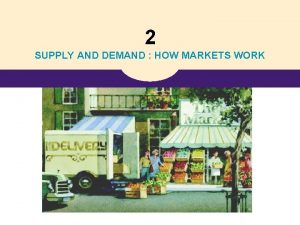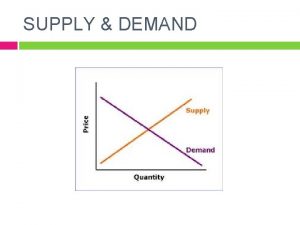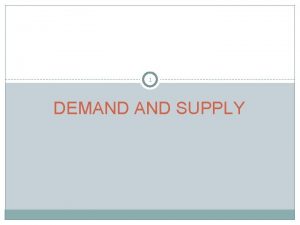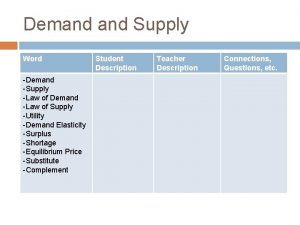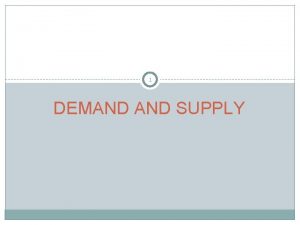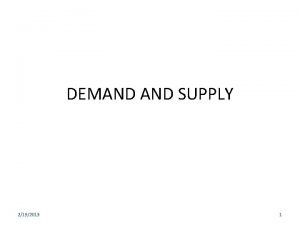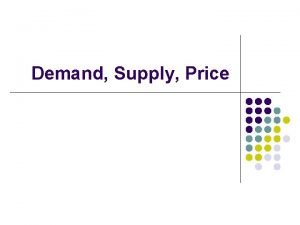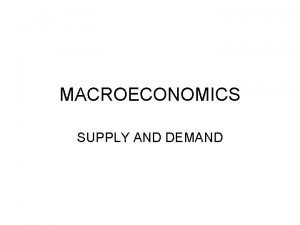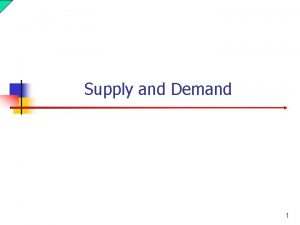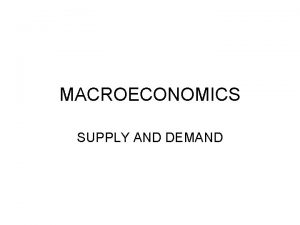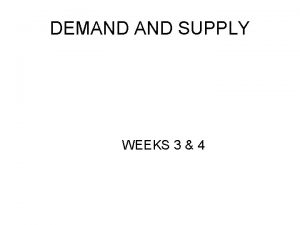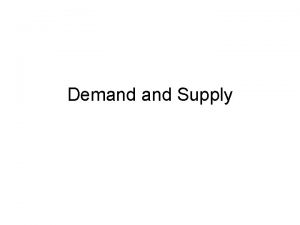Topic 2 Demand Supply 2012 Teach a parrot






























































- Slides: 62

Topic 2 Demand Supply 2012 Teach a parrot to say demand supply and you have made an economist. Copyright 2004 Mc. Graw-Hill Australia Pty Ltd PPTs t/a Microeconomics 7/e by Jackson and Mc. Iver Slides prepared by Muni Perumal, University of Canberra, Australia. 1

Learning Objectives • Develop the concepts of demand supply. • Discuss the factors that lead to shifts in the demand supply curves. • Explain how prices and output are determined in product markets through the interaction of demand supply. Copyright 2004 Mc. Graw-Hill Australia Pty Ltd PPTs t/a Microeconomics 7/e by Jackson and Mc. Iver Slides prepared by Muni Perumal, University of Canberra, Australia. 2

Markets • A market is any institutional structure, or mechanism, that brings together buyers and sellers of particular goods and services • Markets exists in many forms • They determine the price and quantity of a good or service transacted Copyright 2004 Mc. Graw-Hill Australia Pty Ltd PPTs t/a Microeconomics 7/e by Jackson and Mc. Iver Slides prepared by Muni Perumal, University of Canberra, Australia. 3

Demand • The various amounts of a product that consumers are willing and able to purchase at various prices during some specific period • Demonstrated by demand schedule and demand curve Copyright 2004 Mc. Graw-Hill Australia Pty Ltd PPTs t/a Microeconomics 7/e by Jackson and Mc. Iver Slides prepared by Muni Perumal, University of Canberra, Australia. 4

Law of Demand • The inverse relationship between the price and the quantity demanded of a good or service during some period of time Copyright 2004 Mc. Graw-Hill Australia Pty Ltd PPTs t/a Microeconomics 7/e by Jackson and Mc. Iver Slides prepared by Muni Perumal, University of Canberra, Australia. 5

Law of Demand (cont. ) Based on: 1. Income effect 2. Substitution effect 3. Diminishing marginal utility Copyright 2004 Mc. Graw-Hill Australia Pty Ltd PPTs t/a Microeconomics 7/e by Jackson and Mc. Iver Slides prepared by Muni Perumal, University of Canberra, Australia. 6

Income Effect • At a lower price, consumers can buy more of a product without giving up other goods • A decline in price increases the purchasing power of money/real income Copyright 2004 Mc. Graw-Hill Australia Pty Ltd PPTs t/a Microeconomics 7/e by Jackson and Mc. Iver Slides prepared by Muni Perumal, University of Canberra, Australia. 7

Substitution Effect • At a lower price, consumers have the incentive to substitute the cheaper good for similar goods that are now relatively more expensive Copyright 2004 Mc. Graw-Hill Australia Pty Ltd PPTs t/a Microeconomics 7/e by Jackson and Mc. Iver Slides prepared by Muni Perumal, University of Canberra, Australia. 8

Diminishing Marginal Utility • States that successive units of a given product yield less and less extra satisfaction • Therefore, consumers will only buy more of a good if its price is reduced Copyright 2004 Mc. Graw-Hill Australia Pty Ltd PPTs t/a Microeconomics 7/e by Jackson and Mc. Iver Slides prepared by Muni Perumal, University of Canberra, Australia. 9

Demand Curve • Shows the inverse relationship between price and quantity demanded for a good or service • Derived from a demand schedule showing the quantity demanded at various prices Copyright 2004 Mc. Graw-Hill Australia Pty Ltd PPTs t/a Microeconomics 7/e by Jackson and Mc. Iver Slides prepared by Muni Perumal, University of Canberra, Australia. 10

Demand Price per unit a b c d e Quantity demanded per week 5 4 3 2 1 Copyright 2004 Mc. Graw-Hill Australia Pty Ltd PPTs t/a Microeconomics 7/e by Jackson and Mc. Iver Slides prepared by Muni Perumal, University of Canberra, Australia. 10 20 35 55 80 11

Graphing Demand P D 1 a Price ($ per unit) 5 b 4 c 3 d 2 e 1 D 1 0 10 20 30 40 50 60 70 80 Quantity demanded (units per week) Copyright 2004 Mc. Graw-Hill Australia Pty Ltd PPTs t/a Microeconomics 7/e by Jackson and Mc. Iver Slides prepared by Muni Perumal, University of Canberra, Australia. Q 12

Individual and Market Demand • Market demand is derived by horizontally summing individual demand curves • Market demand is derived by adding all the quantities demanded in a demand schedule which correspond to their prices Copyright 2004 Mc. Graw-Hill Australia Pty Ltd PPTs t/a Microeconomics 7/e by Jackson and Mc. Iver Slides prepared by Muni Perumal, University of Canberra, Australia. 13

Deriving the market demand curve from individual curves: Figure 3. 3

Deriving the market demand curve from individual curves: Figure 3. 3, continued

Changes in Demand • Caused by changes in one or other of the non-price determinants of demand • Represented as a shift of the demand curve either to the right or left • Represents a change in the quantity demand at every price, so cannot be related to a change in price Copyright 2004 Mc. Graw-Hill Australia Pty Ltd PPTs t/a Microeconomics 7/e by Jackson and Mc. Iver Slides prepared by Muni Perumal, University of Canberra, Australia. 16

Changes in Demand • Tastes or preferences • Number of buyers • Income – Normal or superior goods—demand varies directly with income – Inferior goods—demand varies inversely with income Copyright 2004 Mc. Graw-Hill Australia Pty Ltd PPTs t/a Microeconomics 7/e by Jackson and Mc. Iver Slides prepared by Muni Perumal, University of Canberra, Australia. 17

Changes in Demand (cont. ) • Prices of related goods – Substitute goods – Complementary goods – Independent goods • Expectations • Seasons/weather Copyright 2004 Mc. Graw-Hill Australia Pty Ltd PPTs t/a Microeconomics 7/e by Jackson and Mc. Iver Slides prepared by Muni Perumal, University of Canberra, Australia. 18

Increase in Demand P 5 D 1 D 2 Price ($ per unit) 4 3 Increase in Demand 2 1 0 D 1 10 20 30 40 50 60 70 Quantity demanded 80 Copyright 2004 Mc. Graw-Hill Australia Pty Ltd PPTs t/a Microeconomics 7/e by Jackson and Mc. Iver Slides prepared by Muni Perumal, University of Canberra, Australia. D 2 Q 19

Decrease in Demand P 5 Price ($ per unit) 4 D 1 Decrease in Demand D 3 3 2 1 0 D 3 10 20 30 40 50 60 70 Quantity demanded 80 Copyright 2004 Mc. Graw-Hill Australia Pty Ltd PPTs t/a Microeconomics 7/e by Jackson and Mc. Iver Slides prepared by Muni Perumal, University of Canberra, Australia. D 1 Q 20

Changes in Quantity Demand • caused by changes in price only • represented as movement along a demand curve • other factors determining demand are held constant Copyright 2004 Mc. Graw-Hill Australia Pty Ltd PPTs t/a Microeconomics 7/e by Jackson and Mc. Iver Slides prepared by Muni Perumal, University of Canberra, Australia. 21

Movement along a Curve P 5 D 1 Price ($ per unit) 4 Movement along a demand curve 3 Change in quantity demanded 2 1 0 D 1 10 20 30 40 50 60 70 Quantity demanded 80 Copyright 2004 Mc. Graw-Hill Australia Pty Ltd PPTs t/a Microeconomics 7/e by Jackson and Mc. Iver Slides prepared by Muni Perumal, University of Canberra, Australia. Q 22

Supply • The various amounts of a product that producers are willing and able to supply at various prices during some specific period • Demonstrated by the supply schedule and supply curve Copyright 2004 Mc. Graw-Hill Australia Pty Ltd PPTs t/a Microeconomics 7/e by Jackson and Mc. Iver Slides prepared by Muni Perumal, University of Canberra, Australia. 23

Law of Supply • Direct relationship between the price and quantity supplied • Increased price causes increased quantity supplied • Decreased price causes decreased quantity supplied • Related to cost-plus pricing model, i. e. as quantity increases costs often increase so firm need a higher P to increase Q. 24 Copyright 2004 Mc. Graw-Hill Australia Pty Ltd PPTs t/a Microeconomics 7/e by Jackson and Mc. Iver Slides prepared by Muni Perumal, University of Canberra, Australia.

Market Supply a b c d e Price Quantity supplied per unit($) per week 5 4 3 2 1 12 000 10 000 7 000 4 000 1 000 Copyright 2004 Mc. Graw-Hill Australia Pty Ltd PPTs t/a Microeconomics 7/e by Jackson and Mc. Iver Slides prepared by Muni Perumal, University of Canberra, Australia. 25

Supply Curve P a 5 b 4 Price ($ per unit) S 1 c 3 d 2 e 1 S 1 0 2 4 6 8 10 12 14 16 Quantity supplied (000/week) Copyright 2004 Mc. Graw-Hill Australia Pty Ltd PPTs t/a Microeconomics 7/e by Jackson and Mc. Iver Slides prepared by Muni Perumal, University of Canberra, Australia. Q 26

Change in Supply • represented as a shift of the supply curve • caused by changes in determinants of supply other than price Copyright 2004 Mc. Graw-Hill Australia Pty Ltd PPTs t/a Microeconomics 7/e by Jackson and Mc. Iver Slides prepared by Muni Perumal, University of Canberra, Australia. 27

Increase in Supply P S 1 5 S 2 Price ($ per unit) 4 3 2 1 0 S 1 2 S 2 4 6 8 10 12 14 Quantity supplied (000/week) 16 Copyright 2004 Mc. Graw-Hill Australia Pty Ltd PPTs t/a Microeconomics 7/e by Jackson and Mc. Iver Slides prepared by Muni Perumal, University of Canberra, Australia. Q 28

Decrease in Supply P S 3 5 S 1 Price ($ per unit) 4 3 S 3 2 1 S 1 0 2 4 6 8 10 12 14 Quantity supplied (000/week) 16 Copyright 2004 Mc. Graw-Hill Australia Pty Ltd PPTs t/a Microeconomics 7/e by Jackson and Mc. Iver Slides prepared by Muni Perumal, University of Canberra, Australia. Q 29

Non-price determinants of Supply • Resource price • Technology • Prices of other goods • Expectations • Number of sellers • [Note mostly related to changing costs of production reflecting marginal cost curve] Copyright 2004 Mc. Graw-Hill Australia Pty Ltd PPTs t/a Microeconomics 7/e by Jackson and Mc. Iver Slides prepared by Muni Perumal, University of Canberra, Australia. 30

Changes in Quantity Supplied • Caused by changes in price only • Represented as a movement along a supply curve Copyright 2004 Mc. Graw-Hill Australia Pty Ltd PPTs t/a Microeconomics 7/e by Jackson and Mc. Iver Slides prepared by Muni Perumal, University of Canberra, Australia. 31

Movement along a Supply Curve P S 1 5 Price ($ per unit) 4 3 Movement along a supply curve 2 1 S 1 0 2 4 6 8 10 12 14 Quantity supplied (000/week) 16 Copyright 2004 Mc. Graw-Hill Australia Pty Ltd PPTs t/a Microeconomics 7/e by Jackson and Mc. Iver Slides prepared by Muni Perumal, University of Canberra, Australia. Q 32

Movement along a Supply Curve P S 1 $5 Price ($ per unit) 4 3 Movement along a supply curve 2 1 S 1 0 2 4 6 8 10 12 14 Quantity supplied (000/week) 16 Copyright 2004 Mc. Graw-Hill Australia Pty Ltd PPTs t/a Microeconomics 7/e by Jackson and Mc. Iver Slides prepared by Muni Perumal, University of Canberra, Australia. Q 33

Deriving the market supply curve from individual curves

Deriving the market supply curve from individual curves Hubbard, Garnett, Lewis and O’Brien: Essentials of Economics © 2010 Pearson Australia

Market Equilibrium • Occurs when the buying decisions of households and the selling decisions of producers are equated • Determines the equilibrium price and equilibrium quantity bought and sold in the market Copyright 2004 Mc. Graw-Hill Australia Pty Ltd PPTs t/a Microeconomics 7/e by Jackson and Mc. Iver Slides prepared by Muni Perumal, University of Canberra, Australia. 36

Market Equilibrium (cont. ) P S Price ($ per unit) 5 4 Equilibrium price 3 2 1 D 0 2 4 6 7 8 10 12 14 Units of X (000/week) 16 18 Copyright 2004 Mc. Graw-Hill Australia Pty Ltd PPTs t/a Microeconomics 7/e by Jackson and Mc. Iver Slides prepared by Muni Perumal, University of Canberra, Australia. Q 37

Market Equilibrium (cont. ) P Price ($ per unit) 5 surplus S 4 Equilibrium price 3 2 1 D 0 2 4 6 7 8 10 12 14 Units of X (000/week) 16 18 Copyright 2004 Mc. Graw-Hill Australia Pty Ltd PPTs t/a Microeconomics 7/e by Jackson and Mc. Iver Slides prepared by Muni Perumal, University of Canberra, Australia. Q 38

Market Equilibrium (cont. ) P Price ($ per unit) 5 surplus S 4 Equilibrium price 3 2 shortage 1 D 0 2 4 6 7 8 10 12 14 Units of X (000/week) 16 18 Copyright 2004 Mc. Graw-Hill Australia Pty Ltd PPTs t/a Microeconomics 7/e by Jackson and Mc. Iver Slides prepared by Muni Perumal, University of Canberra, Australia. Q 39

Shortage (Excess Demand) • Occurs when the quantity demanded exceeds the quantity supplied at the current price • Competition amongst buyers eventually bids up the price until equilibrium is reached Copyright 2004 Mc. Graw-Hill Australia Pty Ltd PPTs t/a Microeconomics 7/e by Jackson and Mc. Iver Slides prepared by Muni Perumal, University of Canberra, Australia. 40

Surplus (Excess Supply) • Occurs when the quantity supplied exceeds the quantity demanded at the current price • Competition amongst producers eventually causes the price to decline until equilibrium is reached Copyright 2004 Mc. Graw-Hill Australia Pty Ltd PPTs t/a Microeconomics 7/e by Jackson and Mc. Iver Slides prepared by Muni Perumal, University of Canberra, Australia. 41

Changes in Demand Supply • Changes or shifts will disrupt the equilibrium • The market will adjust until once again an equilibrium is reached • The equilibrium price and quantity traded will change Copyright 2004 Mc. Graw-Hill Australia Pty Ltd PPTs t/a Microeconomics 7/e by Jackson and Mc. Iver Slides prepared by Muni Perumal, University of Canberra, Australia. 42

Increase in Demand P D 1 D 2 S Equilibrium price & quantity rise D 2 D 1 0 Copyright 2004 Mc. Graw-Hill Australia Pty Ltd PPTs t/a Microeconomics 7/e by Jackson and Mc. Iver Slides prepared by Muni Perumal, University of Canberra, Australia. Q 43

Decrease in Demand P D 2 D 1 S Equilibrium price & quantity fall D 1 0 Copyright 2004 Mc. Graw-Hill Australia Pty Ltd PPTs t/a Microeconomics 7/e by Jackson and Mc. Iver Slides prepared by Muni Perumal, University of Canberra, Australia. D 2 Q 44

Increase in Supply P D 1 S 2 Equilibrium price falls & quantity rises S 1 S 2 0 Copyright 2004 Mc. Graw-Hill Australia Pty Ltd PPTs t/a Microeconomics 7/e by Jackson and Mc. Iver Slides prepared by Muni Perumal, University of Canberra, Australia. D 1 Q 45

Decrease in Supply P D 1 S 2 S 1 Equilibrium price rises & quantity falls S 2 S 1 0 Copyright 2004 Mc. Graw-Hill Australia Pty Ltd PPTs t/a Microeconomics 7/e by Jackson and Mc. Iver Slides prepared by Muni Perumal, University of Canberra, Australia. D 1 Q 46

Both Demand & Supply Increase P D 1 D 2 S 1 Quantity will but price S 2 increase change will be in determinant S 1 S 2 0 Copyright 2004 Mc. Graw-Hill Australia Pty Ltd PPTs t/a Microeconomics 7/e by Jackson and Mc. Iver Slides prepared by Muni Perumal, University of Canberra, Australia. D 2 D 1 Q 47

Demand or Supply change • Increase in D: P increases; Q decreases • Decrease in D: P decreases; Q increases • Increase in S: P decreases; Q increases • Decrease in S: P increases; Q decreases Copyright 2004 Mc. Graw-Hill Australia Pty Ltd PPTs t/a Microeconomics 7/e by Jackson and Mc. Iver Slides prepared by Muni Perumal, University of Canberra, Australia. 48

Both Demand & Supply change • Demand increases and supply increases; Q must rise but P? ? • Demand increases and supply decreases; P must rise but Q? ? • Demand decreases and supply increases; P must fall but Q? ? • Demand decreases and supply decreases; Q must fall but P? ? 49

Both Demand & Supply change • The overall change in the indeterminate side of the market, i. e. P or Q depends on the relative shifts in DD and SS. Copyright 2004 Mc. Graw-Hill Australia Pty Ltd PPTs t/a Microeconomics 7/e by Jackson and Mc. Iver Slides prepared by Muni Perumal, University of Canberra, Australia. 50

Individual Demand Figure 5. 1 Market Demand

Demand, Marginal Benefit, and Consumer Surplus • Consumer surplus – Consumer surplus is the value of a good minus the price paid for it, summed over the quantity bought. – It is measured by the area under the demand curve and above the price paid, up to the quantity bought. – Figure 5. 2 on the next slide shows the consumer surplus for pizza for an individual consumer.

Demand Consumer Figure 5. 2 Surplus

Supply, Marginal Cost, and Producer Surplus • Supply, cost, and minimum supply price – The cost of one more unit of a good or service is its marginal cost, which we can measure as minimum price that a firm is willing to accept. – A supply curve of a good or service shows the quantity supplied at each price. – A supply curve is a marginal cost curve.

Cost, Price, and Producer Surplus • Producer surplus – Producer surplus is the price of a good minus the marginal cost of producing it, summed over the quantity sold. – Producer surplus is measured by the area below the price and above the supply curve, up to the quantity sold. – Figure 5. 4 on the next slide shows the producer surplus for pizza for an individual producer.

Supply and Producer Surplus Figure 5. 4

Is the Competitive Market Efficient? • Efficiency of competitive equilibrium – A competitive market creates an efficient allocation of resources at equilibrium. – In equilibrium, the quantity demanded equals the quantity supplied.

An Efficient Market for Pizza Price (dollars per pizza) Figure 5. 5(a) 25 S Consumer surplus 20 Equilibrium 15 10 5 Producer surplus 0 5 Equilibrium quantity 10 15 D 20 Quantity (thousands of pizzas per day)

Is the Competitive Market Efficient? – At the equilibrium quantity, marginal benefit equals marginal cost, so the quantity is the efficient quantity. – The sum of consumer and producer surplus is maximised at this efficient level of output.

Is the Competitive Market Efficient? • Underproduction and overproduction – Obstacles to efficiency lead to underproduction or overproduction and create a deadweight loss. • Deadweight loss – The decrease in consumer and producer surplus that results from an inefficient allocation of resources

Underproduction Price (dollars per pizza) Figure 5. 6(a) S Deadweight loss 25 20 15 Efficient output 10 If output is reduced to 5, 000 5 0 D 5 10 15 20 Quantity (thousands of pizzas per day)

Overproduction Price (dollars per pizza) Figure 5. 6(b) S 25 20 Deadweight loss 15 10 5 0 D 5 10 15 If output is increased to 15, 000 pizzas 20 Quantity (thousands of pizzas per day)
 Teach a parrot to say supply and demand
Teach a parrot to say supply and demand Module 5 supply and demand introduction and demand
Module 5 supply and demand introduction and demand Matching supply with demand
Matching supply with demand What are the steps in narrowing down research topic
What are the steps in narrowing down research topic General subject example
General subject example Parrot os metapackages
Parrot os metapackages Parrot
Parrot Parrot in the oven chapter 5 summary
Parrot in the oven chapter 5 summary Y hembra
Y hembra What did the mittu see on the tree
What did the mittu see on the tree Bluethroat macaw
Bluethroat macaw Dick finally decided on the boat
Dick finally decided on the boat The smartest parrot once upon a time
The smartest parrot once upon a time Kinds of character in a story
Kinds of character in a story Wrasse fish hawaii
Wrasse fish hawaii Flag with parrot
Flag with parrot Parrot anifi
Parrot anifi Lion parrot
Lion parrot Does a parrot have a backbone
Does a parrot have a backbone I am a parrot grace nichols
I am a parrot grace nichols Michel parrot
Michel parrot Christine parrot
Christine parrot Demand curve halimbawa
Demand curve halimbawa Measures to correct excess demand and deficient demand
Measures to correct excess demand and deficient demand Independent and dependent demand
Independent and dependent demand Inventory models for independent demand
Inventory models for independent demand Individual demand vs market demand
Individual demand vs market demand What is demand forecasting and estimation
What is demand forecasting and estimation Dependent demand example
Dependent demand example Paradox of value
Paradox of value Stochastic inventory model example
Stochastic inventory model example Oil supply and demand
Oil supply and demand Demand n supply
Demand n supply Demand and supply in managerial economics
Demand and supply in managerial economics Money supply and demand graph
Money supply and demand graph The long-run aggregate supply curve shifts left if
The long-run aggregate supply curve shifts left if Planning techniques
Planning techniques Combining supply and demand worksheet
Combining supply and demand worksheet The law of demand states that holding other things constant
The law of demand states that holding other things constant Demand for greebes
Demand for greebes Kurva surplus dan shortage
Kurva surplus dan shortage Matching supply with demand
Matching supply with demand Rumus fungsi penawaran ekonomi
Rumus fungsi penawaran ekonomi Unit 2 demand supply and consumer choice answer key
Unit 2 demand supply and consumer choice answer key Infill
Infill How to calculate aggregate demand
How to calculate aggregate demand Aggregate supply shifters
Aggregate supply shifters Supply and demand of loanable funds
Supply and demand of loanable funds Supply and demand
Supply and demand Double shifts in demand and supply
Double shifts in demand and supply Unit 2 demand supply and consumer choice
Unit 2 demand supply and consumer choice Combining supply and demand answer key
Combining supply and demand answer key Cost-responsiveness efficient frontier
Cost-responsiveness efficient frontier Supply and demand unit test
Supply and demand unit test Permintaan dan penawaran jasa transportasi
Permintaan dan penawaran jasa transportasi Shortage or surplus
Shortage or surplus Supply and demand cheat sheet
Supply and demand cheat sheet Airline supply and demand curve
Airline supply and demand curve Supply demand rule
Supply demand rule Sras lras
Sras lras Supply and demand together
Supply and demand together Interaction of demand and supply
Interaction of demand and supply Chapter 6 supply demand and government policies
Chapter 6 supply demand and government policies




















